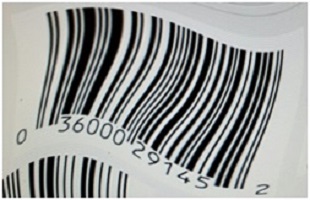Blog – If you are printing barcodes…
Category : Uncategorized
If you are printing barcodes…..
We all see barcodes being scanned almost every day. It has become part of our daily lives. When we see a barcode we automatically assume that it can be scanned, and in fact most can. However, there are many that are ‘bad barcodes’ out there. Do any belong to you?
What is the definition of a bad barcode?
It cannot be scanned by the customer or consumer with their scanner
- Low ISO print quality grade
This is the best way to determine if your barcode is going to work. It is a multifaceted test that can predict a barcode’s scannability with the variety of scanning technologies now in use around the world.
- Inadequate quiet zones
This is the ‘white’ area around a barcode that the scanner uses to set its reference point for the background. The quiet zones are very necessary but very often overlooked.
- Over wrap
A great barcode cannot be scanned if you have placed ‘lines’ of overwrap through it.
- Around an edge
When a barcode wraps around an edge of a package or around the circumference of a cylinder it looks like a partial code or a distorted code to the scanner. These are impossible to decode safely.
- It does not have valid data
Encoded data does not match expected data or include expected fields. Some of today’s principle barcode applications are well defined and have only had minor changes over the years. This is changing as the technology is seen as a tool to meet challenging (and changing) business and social needs.
- The encoded data is not formatted for the application
A Multi-field barcode is not following rules defined in the application. There are many linear and 2D barcodes that contain more than one field of data. Part number, lot number use before date, are just a few of the over 200 possible fields you could find in one barcode. Formatting these barcodes properly adds a level of complexity that can be challenging. An improperly formatted code is about as bad as a completely un-scannable barcode. In some situations it may even be worse.
- The barcode’s bars or cells are too small to be read by the scanner
Linear barcodes X dimension (narrow bar) or 2D barcode cell size is less than the application specifies
- It is not tall enough to be read easily
Linear barcodes height is less than the application specifies
- Just not in compliance with the applicable specs
The nuances of the principle barcode application specifications are too big a subject to cover in this small article. Many would say that the specs have enough complexity and breadth (> 400 pages!) that it really is a job for a computer system rather than a person. The reality is that this is a complex technical task and that a person cannot determine if their company is in compliance without the tools to do the job.
What are the most common mistakes made in printing barcodes?
Not checking your work
Compliance with standards is no longer optional in today’s world. The barcode is used to track, charge, dispense and use, prevent from misuse, prevent from counterfeit, create transactions, etc. It is data, very accurate, very inexpensive, very timely and very valuable. It is part of your product and a reflection on your quality. It is part of the value you put into your products. It expected to work and it is expected that you checked it before putting it out into use.
Using a scanner to check
This is the classic – WWe scanned it here and it worked!”. Consider this: there are at least 6 basic scanning technology types, several hundred sub-types and several thousand brands/models in use here and around the world. Your scanner is just one of those, so if you are checking your quality with a scanner and sleeping at night, stop that. The only way to be safe is to verify your barcodes using a barcode verifier. If you manage a barcode printing function then you should be able to state what quality level you are producing (ISO or ANSI) and produce records to support it.
